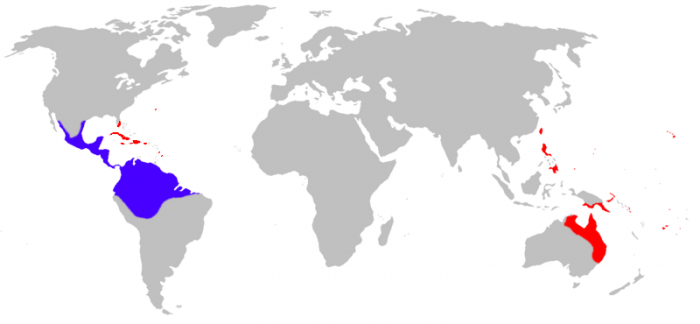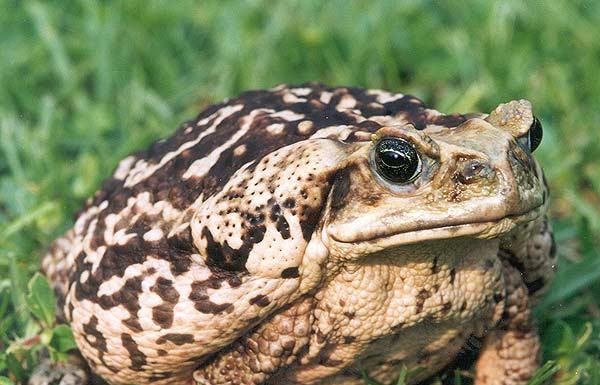Causes of Extinction
All species have a range and a niche. The range of a species is the distribution of all populations of individuals belonging to it. The niche of a species is like its job, how it obtains resources and interacts with other species. Climate change is impacting the range and the niche of all modern species. We will provide several examples of range shift, changes in the distribution of species as a result of climate change, and how it can result in species extinction. Prediction of the future niche of a species, literally whether it will keep or lose its job, is much more difficult, as we will see.
As we saw in Module 7, corals have a significant possibility of extinction in coming centuries as a direct result of anthropogenically-related climate change. With the exception of a few deep-sea species, corals are restricted to a limited upper five meters of the ocean. They need to live in this zone to receive sunlight critical for their algal symbionts. This depth range is forecast to become inhospitable to corals, as decreasing saturation levels and increased temperature and consequent bleaching will render calcification more difficult. Corals will have nowhere to go. They cannot move deeper, so if they cannot adapt, they will become extinct. Remember, adapt, move, or die.
There is ample evidence that climate is impacting the abundance and distribution of modern terrestrial ecosystems as well. Terrestrial species have and will continue to become extinct when they reach the limits of their feasible range and are unable to adapt to the new conditions.
There is overwhelming data, for example, that warming is causing a shift in the ranges of species, generally towards higher latitudes (i.e., towards the poles) and higher elevations in mountainous areas, where conditions are cooler. Species can literally be driven off the top of a mountain as they, or their predators, seek a cooler habitat. A good example of this is the Toucan, a large-billed bird that inhabits mountainous areas of Central America and is being forced to relocate to higher elevations to seek out cooler and wetter conditions. The omnivorous Toucan has become a predator of the infant Quetzal, an extremely beautiful bird that lives in its new habitat elevations. The Toucan picks the baby Quetzals out of their nest with its long beak and is causing Quetzal populations to drop.
Birds
In the higher latitudes, species can be forced to the margins of a continent or have their natural habitat or food supply profoundly altered by climate change. Cases in point are the polar bears, discussed in significant detail later in this module, and penguins. Both Adelie and Emperor penguin populations have decreased by more than 50% in Antarctica as a result of melting sea ice and their continual poleward range shift in search of a stable habitat.
Island inhabitants are extremely sensitive to extinction as a result of climate change and other impacts of humans' activity. Island species have a limited gene pool and often have a very specialized niche. Range shift is an extremely effective extinction mechanism; there is literally nowhere to move to. The widely cited case in point are birds that were endemic to islands in the Pacific, from Micronesia to Polynesia and New Zealand. Research shows that the magnitude of bird extinction as a result of human colonization of the Pacific Islands was staggering, about two-thirds of bird species went extinct between the time humans colonized the island and the first European settlers arrived. As we saw in Module 10, islands are extremely susceptible to sea level rise and loss of habitat is also a potential extinction mechanism in the future. In the past, snakes have become extinct at high rates on Mediterranean islands as sea level rose in the last 18,000 years.
With the exception of high latitudes, mountainous regions and islands, range shift is not generally an extinction mechanism on its own. More threatening to the livelihood of a species is when its niche changes due to competition, or when other human-induced agents become involved. One of the most serious impacts on species' ability to thrive is invasive species and other introduced agents such as pathogens. Later in this module, we will see that pathogens may be responsible for the demise of the Golden Toad and the decline of the honey bees.
Cane Toads
There is almost nothing as disturbing to an ecosystem as an invasive species. And possibly the best example of the havoc an invasive species can wreak is the Cane Toad. Native to Central and South America, the Cane Toad is a large amphibian species that is a voracious consumer of insects. The toad was introduced to Caribbean Islands, Australia, and elsewhere in the hope that it would help control agricultural pests. The toad was brought to Australia in 1935 to help prevent the destructive cane beetle from consuming the sugar cane crop. This experiment has been a dramatic failure, and today the Cane Toad is possibly the most infamous invasive species in the world and the most hated creature in Australia.
The Cane Toad does eat voraciously. But unfortunately, it has not just fed on the cane beetle. Today it preys upon small rodents, snakes, and marsupials. One species that has become endangered as a direct result of Cane Toad predation is the Northern Quoll. Certain species of lizards and snakes have also declined. However, this is not the end of the story. The Cane Toad population has surged as a result of its ability to reproduce rapidly and the lack of a natural predator. An individual female can produce 8000-25000 eggs at once in gelatinous strings that are up to 20 meters in length. Juvenile toads grow rapidly and readily reach sexual maturity. As a result, the Cane Toad population in Australia has grown from the initial introduction of 100 individuals to over 200 million today. Because the toads are so large they can move rapidly, up to 40 kilometers per year, so they have spread over much of the northern tier of the continent.

The trait that makes the Cane Toad so potentially threatening, besides its explosive growth, is the poisonous secretions produced by its salivary glands when threatened. Even tadpoles are highly toxic. The toxins are particularly deadly to small animals, but they also threaten populations of crocodiles and turtles. The long-term impact of the Cane Toad is yet to be determined. However, the toad is a serious threat to ecosystems, and methods to control their populations have been unsuccessful. In the process of their remarkable expansion, Cane Toads have become an enemy of the Australian public, who fight them off with cricket bats and golf clubs.

